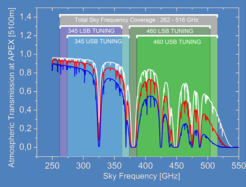FLASH+ First Light APEX Submillimeter Heterodyne receiver

FLASH is a dual-frequency MPIfR principal investigator (PI) receiver, operating simultaneously - on orthogonal polarizations - in the 345GHz and the 460GHz atmospheric windows. Design and construction of the instrument was launched in late 2003; the receiver has been in continuous operation since June 2004. In its first incarnation, equipped with a 460 GHz and a 810 GHz channel, FLASH was the high frequency heterodyne workhorse during the commissioning of the APEX and its first years of operation. After successful installation of the CHAMP+ array, covering also the 810 GHz atmospheric window, we decided in late 2009 to replace the FLASH high frequency channel with a state-of-the-art sideband separating 345 GHz detector. The 2SB mixer was provided by IRAM (D.Maier et al. 2005). In 2012 a NAOJ developed 2SB wideband 460 GHz mixer was installed (Naohisa Satou et al. 2008). Supported by wideband solid-state local oscillator sources from Virginia Diodes Inc., FLASH+ now provides continuous sky frequency coverage from 268 to 516 GHz. Since this last upgrade the receiver is operated remote-controlled and tuning is fully automatical. For a detailed discussion of the receiver and its performance we refer to T. Klein et al. (2013, in preparation).
The large RF tuning ranges, the wide IF bandwidths of 4x 4 GHz when both mixers are operated in parallel are perfectly suited for efficient line surveys in these atmospheric windows. Its excellent stability figures have been utilized for numerous line mapping projects, but also for (extragalactic) studies of weak broad lines.

The PI instrument is available to the APEX user community on a collaborative basis with the MPIfR. The design of the receiver layout will allow future upgrades to new technologies like the integration of photonic local oscillators, the implementation of new frequency bands (contact Bernd Klein).

